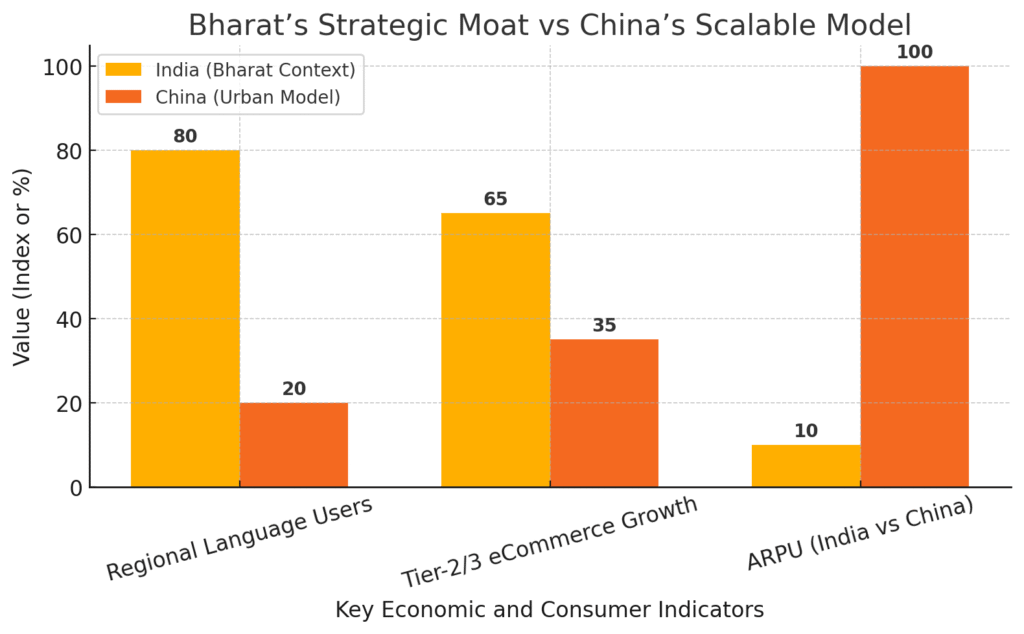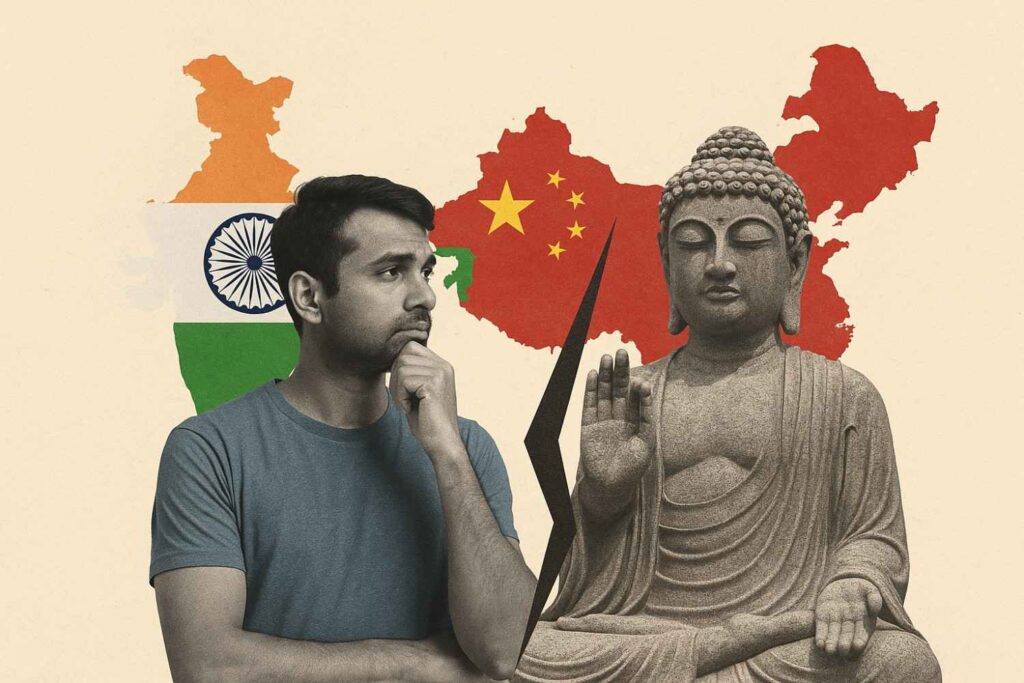Table Of Content
- The India-China Comparison Obsession: A False Benchmark
- The Structural Reality—Two Nations, Two Economies
- China’s State-Driven Tech Model
- India’s Founder-Driven Ecosystem
- Copycat Thinking Is Killing Original Bharat Innovation
- The “China Did It First” Trap
- The Bharat Context Is a Strategic Moat
- India’s Tech Leap Will Be Cultural, Not Industrial
- Bharat Doesn’t Need Mega Factories—It Needs Micro Empowerment
- The Contrarian Lens—Stop Chasing China, Start Owning Bharat
- Why Comparisons Shrink Ambition
- What Bharat Founders Should Focus On Instead
- 1. Build for Bharat’s Trust Gap, Not Just Tech Stack
- 2. Design for Low-Cost, High-Impact Innovation
- 3. Localize User Experience Beyond Language
- 4. Build Ecosystem, Not Empire
- The Strategic Advantage—India’s Ethical Tech Edge
- What This Means for Founders
- Key Takeaway — The Next Leap Belongs to Bharat, Not Beijing
The India-China Comparison Obsession: A False Benchmark
At every startup event, policy meet, or investor roundtable, one refrain dominates: “China did it in 15 years, India will do it faster.”
It sounds inspiring. But the truth is—it’s misleading.
India’s startup ecosystem is not a younger version of China’s. It’s an entirely different civilization of entrepreneurship shaped by Bharat’s social fabric, digital access, and economic realities.
When we use China as the yardstick, we force Indian founders into mimicry—chasing the wrong playbook in a country that plays by entirely different rules.
At Startup Mahakumbh 2025, a controversial exhibition illustrated this point vividly. One side of the display showed Chinese startups building high-end tech in robotics and AI. The other? Indian startups delivering groceries and rides. The comparison went viral for all the wrong reasons—and rightly so.
Because the real question isn’t “When will India catch up to China?”
It’s: “Why are we still trying to?”
Unlike China’s state-driven tech expansion, Bharat’s founder movement thrives on distributed innovation. For a deeper perspective, explore this complete guide to Bharat startups and rural innovation.
As detailed in the Startup Nation: India government report, India’s grassroots innovation is already rewriting the global entrepreneurship playbook.
The Structural Reality—Two Nations, Two Economies

China’s State-Driven Tech Model
China’s ecosystem was born in a tightly managed economy. The government defined the direction—5G, EVs, AI, semiconductors—and poured billions into strategic clusters.
Founders followed clear state blueprints. Industrial zones, manufacturing subsidies, and credit pipelines made scaling predictable.
China’s innovation, in short, is planned.
India’s Founder-Driven Ecosystem
India’s evolution, by contrast, is bottom-up. It thrives on private risk capital, open-market chaos, and the hustle of first-generation founders.
Where China had policy direction, India had friction. But that friction—bureaucratic, infrastructural, and social—has built more resilient founders than any state plan ever could.
Indian entrepreneurs are not state-funded technocrats—they are survivalists.
They innovate not in research parks but in Tier-2 garages, WhatsApp groups, and Telegram founder forums.
This distinction isn’t weakness—it’s our unfair advantage.
Copycat Thinking Is Killing Original Bharat Innovation
The “China Did It First” Trap
Every new wave—EVs, AI, fintech, logistics—comes with a predictable narrative: “Let’s do the China version.”
But copying China’s model ignores India’s radically different consumer base, infrastructure, and cultural context.
For instance:
- China’s Taobao built on massive urban density and disposable income.
- India’s Bharat commerce runs on frugality and low-ticket aspirations.
Trying to replicate “super apps” in India failed repeatedly because our consumers don’t live their digital lives the way Chinese urbanites do. They live in the world of shared data, patchy logistics, and regional language dependency.
The Bharat Context Is a Strategic Moat

India’s real opportunity lies in what China can’t replicate—our diversity, multilingual complexity, and deep informal economy.
Consider:
- 80% of Bharat’s digital users engage in regional languages.
- 65% of e-commerce growth in 2025 comes from Tier-2 and below cities.
- Average revenue per user (ARPU) remains 1/10th of China’s.
Yet founders keep chasing venture metrics instead of value localization.
The next leap won’t come from copying China’s infrastructure—it’ll come from decoding Bharat’s mindset.
India’s Tech Leap Will Be Cultural, Not Industrial
Bharat Doesn’t Need Mega Factories—It Needs Micro Empowerment
China’s growth came from industrial scale; India’s will come from distributed scale.
In China, value was created by massive supply chains.
In Bharat, it will be created by connecting millions of small producers, service providers, and local innovators.
Platforms like ONDC, Udaan, and Meesho are early signs of this shift—democratizing commerce rather than centralizing it.
When we romanticize China’s manufacturing prowess, we ignore India’s unique strength: the ability to organize unorganized sectors digitally.
That’s not imitation—it’s reinvention.
The Contrarian Lens—Stop Chasing China, Start Owning Bharat

Why Comparisons Shrink Ambition
The India-vs-China comparison feeds an inferiority complex.
Founders measure progress in terms of “how fast we’re catching up,” not “how differently we’re leading.”
But innovation isn’t a race against China—it’s a race to unlock Bharat’s dormant potential.
When founders chase Chinese-style valuation playbooks, they overlook the trust gap that Bharat consumers still face online.
When they mimic China’s industrial centralization, they ignore India’s distributed opportunity.
Our job isn’t to industrialize like China.
It’s to humanize innovation for Bharat.
What Bharat Founders Should Focus On Instead
1. Build for Bharat’s Trust Gap, Not Just Tech Stack
The next big moat is trust infrastructure—how to build credibility in markets where people don’t trust new brands easily.
- Transparent pricing
- Real reviews, not fake influencer campaigns
- Vernacular communication that feels personal
Founders who bridge the trust gap will win Bharat—not those chasing hypergrowth.
2. Design for Low-Cost, High-Impact Innovation
China’s innovation was capital-intensive. Bharat’s must be capital-efficient.
That means founders must re-learn how to make ₹1 of marketing deliver ₹5 of value.
Frugality is not a weakness—it’s our competitive DNA.
3. Localize User Experience Beyond Language
Bharat’s digital consumer is not one person—it’s 600 million micro-cultures.
Localization isn’t translation—it’s empathy.
From UI color palettes to cash-flow design, Bharat needs contextual innovation.
4. Build Ecosystem, Not Empire
Instead of chasing monopolies, Bharat founders should think of collaborative ecosystems—partnerships, open APIs, shared logistics, and local mentor networks.
Growth will come not by owning everything but by enabling everyone.
The Strategic Advantage—India’s Ethical Tech Edge
China’s rise came with a cost: surveillance, censorship, data exploitation.
India has a chance to differentiate by embedding ethics in innovation.
Our startup culture can champion transparency, privacy, and inclusivity.
And when global investors seek “trustworthy innovation geographies,” Bharat can be that brand.
This is where MybrandPitch’s philosophy aligns perfectly—empowering authentic, grassroots founders to tell their stories, not manipulate the market.
The world doesn’t need another China.
It needs a new kind of innovation powered by Bharat’s honesty, hustle, and human connection.
What This Means for Founders
If you’re building a startup in Bharat, here’s the mindset shift to embrace:
| Old Thinking (Copying China) | New Thinking (Owning Bharat) |
|---|---|
| Growth by capital intensity | Growth by community trust |
| Centralized scale | Distributed empowerment |
| English-first markets | Vernacular-first experiences |
| Export-led ambition | Local resilience and inclusion |
| Regulatory avoidance | Ethical, transparent growth |
This is not a race to replicate—it’s a movement to redefine.
Key Takeaway — The Next Leap Belongs to Bharat, Not Beijing
The myth of India vs China tech comparison reduces our identity to a contest we never signed up for.
China’s model worked for China. Ours will work for Bharat—if we stop looking sideways and start looking inward.
India doesn’t need to out-China China.
It needs to out-Bharat Bharat.
That’s where the real leap lies—not in speed, but in soul.



